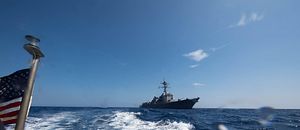For 70 years the United States has dominated Southeast Asia with both hard and soft power — the capability to use economic or cultural influence to shape the preferences of others. Soft power underpins and makes possible robust hard power relationships. But some analysts and policymakers refuse to recognize that U.S. influence and its relationships in Southeast Asia are much shallower and more ephemeral than assumed.
Indeed, despite U.S. enticement and pressure, U.S. allies Australia, Japan, and the Philippines have so far declined U.S. requests to join its freedom of navigation operations in the South China Sea against China’s claims. Indonesia has expressed disapproval over such U.S. “power projection” in the area. U.S. relations with Thailand have not been close since the military coup there in 2014 and Bangkok seems to be leaning toward China. Malaysia-U.S. relations have been brittle since the United States took a legal interest in Prime Minister Najib Razak’s international financial dealings. Even staunch U.S. strategic partner Singapore seems to be seeking a more neutral position between Washington and Beijing.
A recent example of this decline of U.S. soft power was the reaction of the Philippines regarding the January 17 USS Hopper freedom of navigation operation (FONOP) near Scarborough Shoal. The Shoal is claimed by China, Taiwan, and the Philippines. The U.S. Navy guided missile destroyer sailed through the 12 nautical mile territorial sea around the disputed feature. The Hopper’s transit was in innocent passage, which is generally considered legal (if somewhat provocative). China requires permission for innocent passage by warships and objected.
For the United States, this FONOP was a demonstration of international law. But it got no support from its ally, the Philippines. Indeed, to Washington’s chagrin, Philippine presidential spokesperson Harry Roque told the Straits Times, “For us, that [referring to China’s protest against the FONOP] is really a problem of America because we have come to a point that we now have an independent foreign policy… The problem of America today is no longer the problem of the Philippines.”
The U.S. Embassy in Manila responded, “[We] believe that ‘U.S. military personnel partnering with the [Armed Forces of the Philippines] is a more accurate description of the role of any U.S. military presence here.”
Some U.S. observers seemed shocked at the Philippines’ position, but this reality has been evolving for some time. It clearly manifested itself last August when ASEAN leaders and their dialogue partners, including China and the United States, held a series of key security meetings in the Philippines, which then held ASEAN’s rotating chair. The joint communiqué of the ASEAN Foreign Ministers Meeting strongly favored China’s preferences over its opponents within ASEAN as well as the United States. Some saw this as a new diplomatic low for Washington. Indeed, according to Philippine analyst Richard Heydarian, it was “a slam dunk diplomatic victory for China.”
Around the same time, in August 2017, Philippine Foreign Minister Alan Cayetano scolded those pundits who criticized the presence of Chinese ships in the South China Sea but did not criticize the presence of U.S. warships in the disputed waters. He said, “You have to realize that their reason for being is to pursue the interest of the American people. So … we have to pursue Philippine interest.” If Southeast Asian senior officials are stating such sentiments in public they may well be expressing more fundamental concerns in private. But it seems that the United States is not listening.
Instead, the United States has doubled down on its current policy regarding the South China Sea in stepping up the frequency of its FONOPS and declaring China a “strategic competitor.” Many in Southeast Asia fear getting caught between the United States and China in their struggle for dominance in the region. Yet some analysts continue to support provocative U.S. military forays there, ignoring the fact that such moves are increasingly unwelcome even among China’s rival claimants.
One example is a recent piece in Foreign Affairs. After disparaging what it perceives to be the tepid U.S. response, the piece offers some wishful thinking as to how the United States can deter China in the South China Sea. In particular, it encourages Washington to convince “the Duterte government to follow through on plans to allow upgrades at all five previously agreed-upon bases, reverse its decision to ban the storage of ammunition at them, and permit a regular schedule of U.S. combat aircraft rotations.” It also urges “the U.S. government to publicly state that its commitment to defend Philippine troops, ships, and planes from attack under Article V of the two countries’ Mutual Defense Treaty applies to contested waters and islands in the South China Sea.” No mention is made as to how the United States can convince the Philippines to do something its government is not particularly interested in doing.
They say the most difficult journey begins with the first step. The first step for the United States regarding Southeast Asia is to recognize reality. Then Washington needs to adjust its policies and approach accordingly.
Mark J. Valencia is an Adjunct Senior Scholar at the National Institute for South China Sea Studies, Haikou, China

































